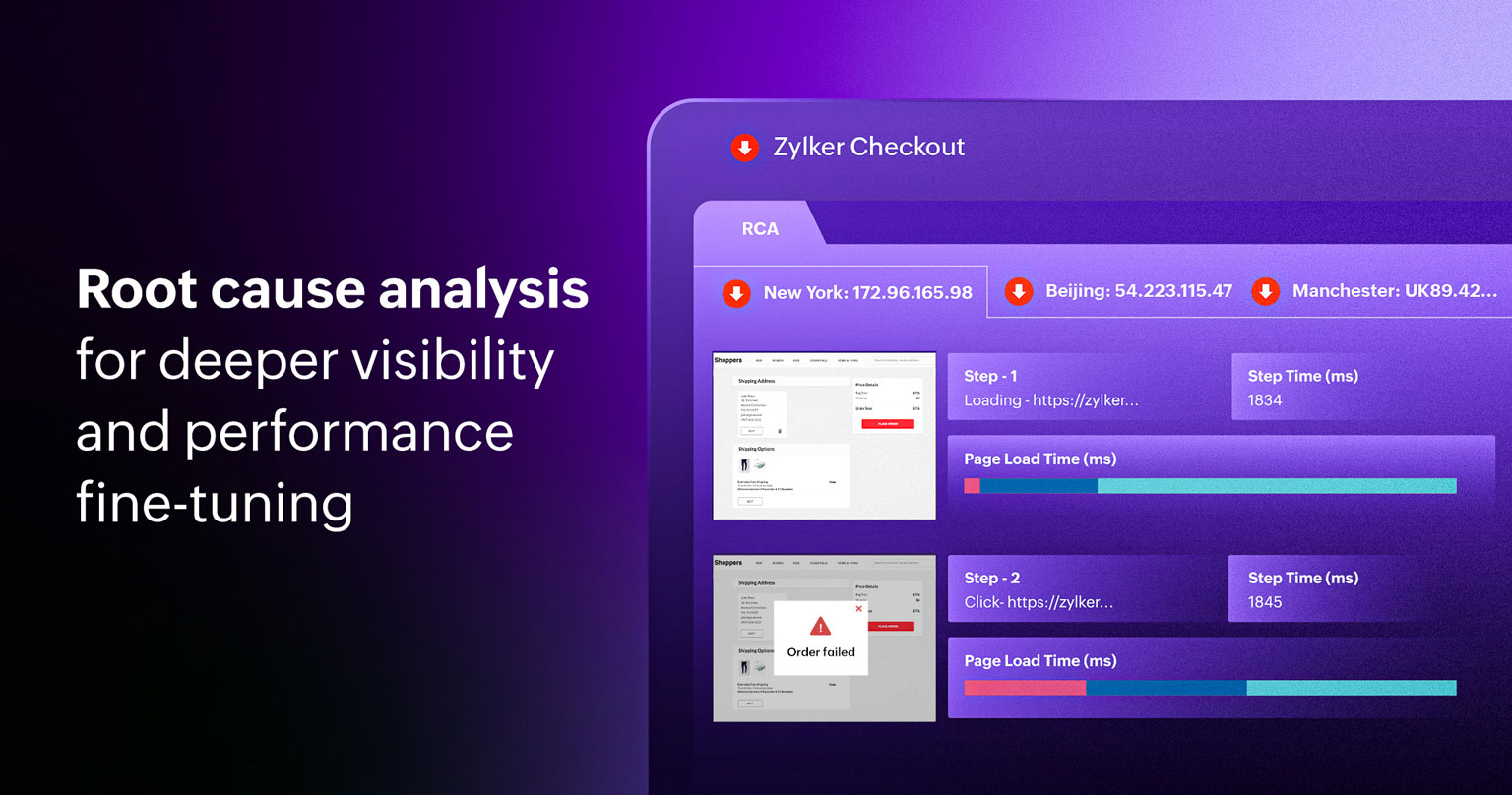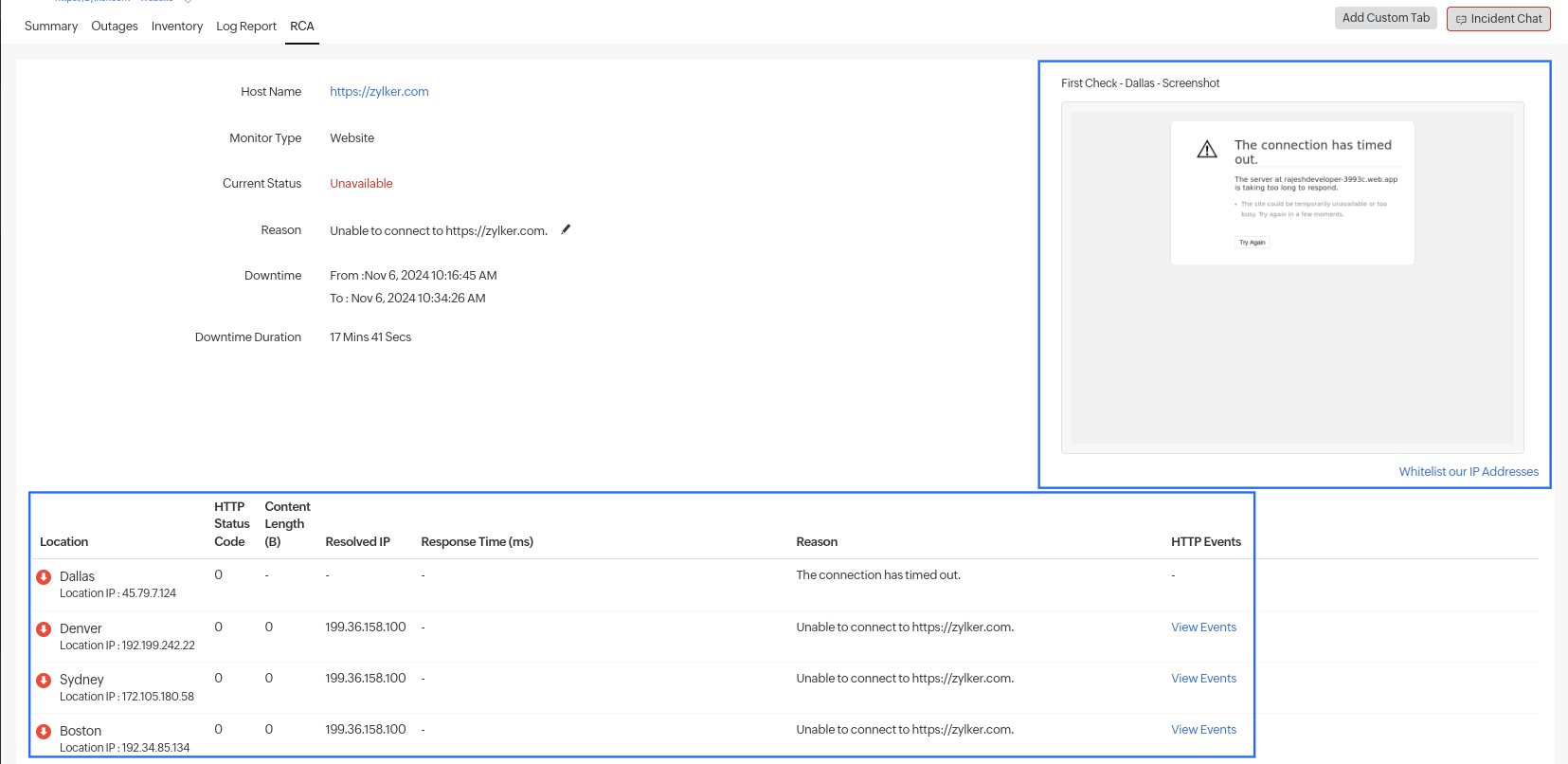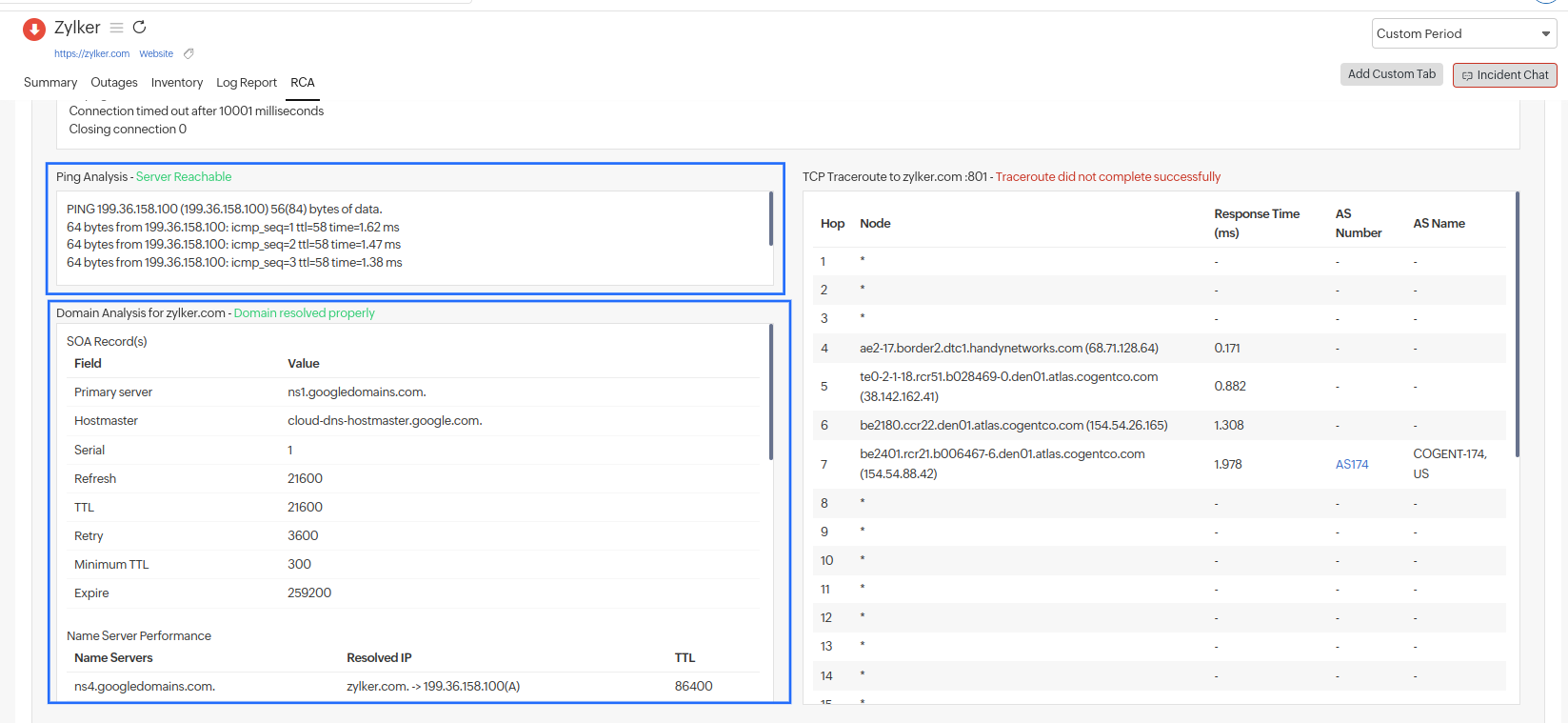Enhance your website and internet service performance with a detailed RCA report

Without visibility into webpage performance metrics, organizations risk encountering several critical challenges. These challenges include slow load times deterring potential customers, difficulty in troubleshooting performance bottlenecks, inefficient resource allocation, missed opportunities for optimization, and a damaged brand reputation due to poor user experience.
A root cause analysis (RCA) is an essential solution for organizations to obtain visibility into the important metrics, to prevent recurring issues, optimize resource allocation, protect brand reputation, drive business growth, and adhere to compliance regulations. Site24x7's RCA goes beyond standard downtime alerts, providing in-depth insights into the root cause of outages. By analyzing various data points, Site24x7 helps you pinpoint the exact source of the problem so you can take corrective measures.
What are the main aspects of Site24x7's RCA?
With Site24x7's RCA, you can obtain:
Location-wise details
Without location-specific details, it's difficult to identify and address problems specific to certain locations, tailor content delivery to improve performance for users in different regions, and ensure compliance with data privacy or localization requirements.
RCA can be a valuable tool for obtaining location-specific performance details. It helps to identify regional performance bottlenecks, understand the performance of CDNs, optimize content delivery, provide visibility into ISP latency and other network-related issues, identify and resolve network latency or congestion problems affecting specific locations, and ensure your website complies with relevant regulations.

DNS analysis
Longer DNS resolution times can lead to slow loading web pages, missing or incorrect DNS records that make the website inaccessible to users, and a compromised DNS record that redirects users to malicious websites.
By examining the DNS records, resolution times, and network connectivity, you can identify and address issues related to DNS configuration, propagation delays, server outages, and security threats. This ensures a seamless digital experience for your users and protects your website's integrity.
SSL certificate checks
If SSL certificates are not regularly checked and maintained, organizations might face several serious consequences like security breaches, data breaches, loss of customer trust, and reputation damage. Staying updated on the date of certificate expiry avoids this issue.

Performance analysis
Without regular webpage performance analysis, organizations might face several critical challenges like slow load times, errors, and crashes that frustrate users, leading to increased bounce rates and decreased customer satisfaction. Identifying and resolving performance bottlenecks becomes more challenging without real-time data and insights.
By comparing page screenshots, HTML, and resources, using the RCA, you can identify any change in the web application. Without proper API monitoring, organizations might face several critical challenges, like unexpected downtimes that disrupt business operations and lead to customer dissatisfaction. Slow response times, errors, and timeouts can negatively impact user experience, and unmonitored APIs might be susceptible to attacks like unauthorized access or data breaches. Inefficient API usage can also lead to increased costs and suboptimal performance.
By proactively identifying and addressing API-related issues before they impact users, you can improve response times, reduce latency, detect and mitigate security threats, optimize API usage and infrastructure. This also helps you meet industry-specific requirements and ensure a seamless and reliable application or site experience for users.
Network traceroute analysis
Unnoticed network problems can lead to increased downtime and disruptions to your services. Network issues can also indicate security breaches or vulnerabilities, and without a traceroute, it might be difficult to identify and address these risks.

Visibility into critical business transactions
The lack of better visibility into the performance of business-critical web transactions might cause challenges like critical transactions experiencing unexpected outages, slow response times, errors, and timeouts that hinder productivity, security threats such as unauthorized access or data breaches, and dwindling customer trust and damaged brand reputation.
By effectively identifying issues that are affecting the flow of transactions, and obtaining trace-related data through a seamless integration with application performance monitoring tool, organizations can proactively identify and address issues before they impact users. These efforts can improve response times and reduce latency, detect and mitigate security threats, optimize transaction processing and infrastructure, meet industry-specific requirements, and ensure a seamless and reliable experience for users.
Webpage content analysis
Changes in webpage content can introduce new performance bottlenecks or inefficiencies. Without analysis, these opportunities for optimization might be overlooked. Understanding changes on webpage content is also crucial for pinpointing the causes of performance issues or any security breach. Performance issues caused by changes in webpage content can impact user experience, leading to increased bounce rates and decreased customer satisfaction.
By capturing visual snapshots of your website, comparing webpage content, and examining the performance of your CDNs, and network factors, you can pinpoint the root cause of issues and take targeted corrective action. This ensures a seamless online experience for your users and minimizes downtime.
Downtime screenshots
Without a visual context of how pages are loading, it can be more difficult to pinpoint the root cause of issues related to layout changes, missing elements, or other visual anomalies. Comparing screenshots can also provide valuable clues and expedite the troubleshooting process.
Site24x7's RCA feature captures visual snapshots of your website at the exact moment of downtime. They provide valuable insights into the nature of the issue. By analyzing these snapshots, you gain a better understanding of the root cause to take targeted corrective action.
HTTP request analysis
Incorrect or missing headers can cause slow load times, errors, or other performance issues. Improperly configured headers can create security vulnerabilities and prevent your website from working properly with other systems, such as web browsers or CDNs. Search engines might penalize websites with incorrect or missing headers, affecting their search engine rankings.
By examining error codes, resource usage, network latency, API interactions, and authentication issues, you can pinpoint the source of problems and take targeted corrective action to ensure a seamless user experience.
Usecase: Troubleshooting slow website load times with Site24x7's RCA
Imagine your e-commerce website is experiencing slow load times, leading to frustrated customers and lost sales. Using Site24x7's RCA, you can systematically investigate and resolve the issue.
- Gathering data
To identify the root cause of slow load times effectively, it's essential to gather comprehensive data. Utilize Site24x7 to monitor performance metrics such as response times, error rates, and other relevant indicators. Actively seek feedback from customers who have experienced slowdowns. This combination of data will provide a valuable foundation for your analysis. - Analyzing DNS resolution
To identify the root cause of slow load times effectively, it's essential to gather comprehensive data and conduct a thorough DNS resolution analysis. Utilize Site24x7 to monitor performance metrics and collect user feedback. Verify the accuracy of DNS records and use Site24x7 to diagnose any issues. By combining these approaches, you can pinpoint the source of slowdowns and take targeted corrective action. - Examining network traces
Traceroute and My Traceroute are essential for identifying network bottlenecks and routing issues. By analyzing network traffic, you can pinpoint congestion, misrouting, and latency problems, ensuring a seamless network experience. - Inspecting HTTP requests
By examining HTTP request headers, you can identify server-side errors, resource-intensive elements, network latency, API interactions, and authentication issues. This information helps pinpoint the root cause of downtime and empowers you to take targeted corrective action, ensuring a seamless user experience. - Reviewing the webpage content
By identifying changes in elements, resources, or third-party content, you can pinpoint the causes of slow load times and take targeted corrective action, ensuring a faster and more responsive website for your users. - Optimizing the website performance
By optimizing your code, implementing caching, improving database performance, and upgrading hardware, you can significantly enhance your website's speed and responsiveness. These optimizations lead to a better user experience and improved overall performance.
If you'd like to optimize your webpages, try Site24x7's website monitoring free trial today and experience how data-rich dashboards and reports ensure better availability and performance.
Topic Participants
Bela Susan Thomas